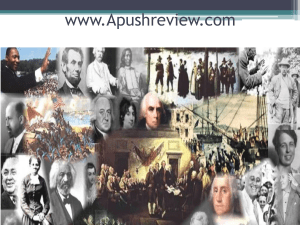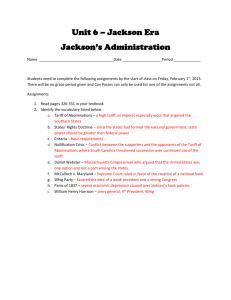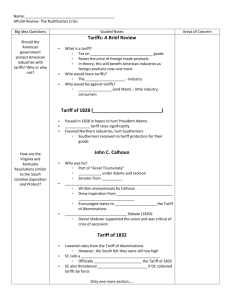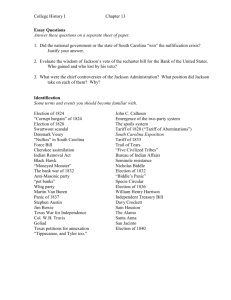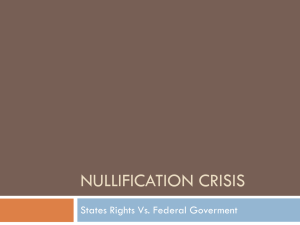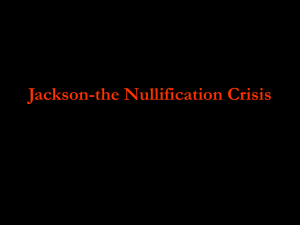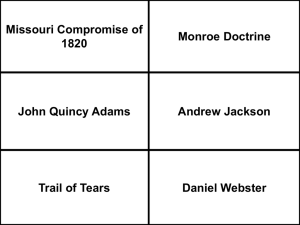1828 Tariff of Abominations
advertisement
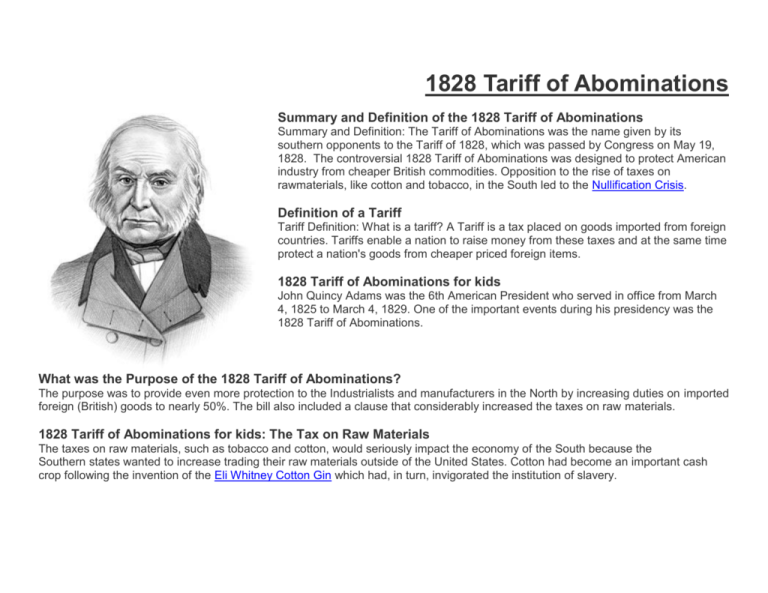
1828 Tariff of Abominations Summary and Definition of the 1828 Tariff of Abominations Summary and Definition: The Tariff of Abominations was the name given by its southern opponents to the Tariff of 1828, which was passed by Congress on May 19, 1828. The controversial 1828 Tariff of Abominations was designed to protect American industry from cheaper British commodities. Opposition to the rise of taxes on rawmaterials, like cotton and tobacco, in the South led to the Nullification Crisis. Definition of a Tariff Tariff Definition: What is a tariff? A Tariff is a tax placed on goods imported from foreign countries. Tariffs enable a nation to raise money from these taxes and at the same time protect a nation's goods from cheaper priced foreign items. 1828 Tariff of Abominations for kids John Quincy Adams was the 6th American President who served in office from March 4, 1825 to March 4, 1829. One of the important events during his presidency was the 1828 Tariff of Abominations. What was the Purpose of the 1828 Tariff of Abominations? The purpose was to provide even more protection to the Industrialists and manufacturers in the North by increasing duties on imported foreign (British) goods to nearly 50%. The bill also included a clause that considerably increased the taxes on raw materials. 1828 Tariff of Abominations for kids: The Tax on Raw Materials The taxes on raw materials, such as tobacco and cotton, would seriously impact the economy of the South because the Southern states wanted to increase trading their raw materials outside of the United States. Cotton had become an important cash crop following the invention of the Eli Whitney Cotton Gin which had, in turn, invigorated the institution of slavery. 1828 Tariff of Abominations Why was the Tariff of 1828 called the Tariff of Abominations? It was called the Tariff of Abominations by Southerners who strongly resented the protection the increase in duties gave the Northerners and the Westerners at the expense of the Southerners. The word 'Abomination' encompasses the meaning of words such as outrage, hatred, scandal and disgrace - this conveys the level of opposition by Southerners to the Tariff of 1828. Who opposed the 1828 Tariff of Abominations? Why was it opposed? The 1828 Tariff of Abominations was opposed by the Southern states that contended that the tariff was unconstitutional. The Southern states whose livelihoods were being harmed firstly by having to pay higher prices on goods the South did not produce, and secondly increasing taxes on British imports made it difficult for Britain to pay for the cotton they imported from the South. Some New England industries were also opposed to the bill because it included the clause by which the taxes on raw materials increased considerably. 1828 Tariff of Abominations for kids: The Three Protective Tariffs The 1828 Tariff of Abominations was the third protective tariff implemented by the government. The protective tariffs taxed all foreign goods, to boost the sales of US products and protect Northern manufacturers from cheap British goods. The Tariff of 1816 placed a 20-25% tax on all foreign goods o It followed the wave of Nationalism in the country following the War of 1812. o The Tariff of 1816 greatly benefited the manufacturers in the North o The invention of the Cotton Gin had turned cotton into a highly lucrative cash crop so the Southerners were making money o The 'American System', the economic plan for the nation advocated by Henry Clay, was being implemented by the government to improve the lives of Americans o Everything was going well during the Era of Good Feelings The Tariff of 1824 was the second protective tariff. It raised the duties still higher. There was 35% duty on imported iron, wool, cotton, and hemp. o But there was opposition from the Southerners who did not benefit from the Tariff of 1824 o Nationalism was transforming into Sectionalism o The north was becoming increasingly industrialized whilst the south was remaining agricultural o The sectional interests of the North and the South truly came into conflict for the first time o The South, who had once favored Henry Clay's Tariff 1816 and his American System which financed the construction of new roads to the west, now opposed both The Tariff of 1828 (the Tariff of Abominations) was the third protective tariff and taxes increased to nearly 50% o The Southern politicians, led by Andrew Jackson, had come up with a scheme to prevent a law being passed. But their plan backfired... 1828 Tariff of Abominations for kids: The Political Schemes The presidential election was to be held in 1828 and the campaigns were underway. John Quincy Adams and Andrew Jackson were the only two candidates. National Republicans voted for John Quincy Adams and Democratic-Republicans and voted for Andrew Jackson. Both were working to obtain votes. Jackson supporters, with a strong southern base, normally opposed the protective tariffs advanced by the Adams political party. The manufacturers and industrialists in the North had started to agitate the Adams administration for even higher protective duties The campaigners for Andrew Jackson men devised a plan by which they would appear to favor higher duties, thus appealing to voters in the North, while at the same time they were really opposing them They therefore proposed high duties on manufactured goods to curry favor with the Northern manufacturers They also proposed high duties on raw materials Jackson's men believed that the manufacturers would oppose the passing of the bill because the high duties on raw materials would cause them considerable damage They also believed that when the bill failed to pass it would please the Southern cotton growers But the plan did not work - the Bill was passed and branded by Southerners as the Tariff of Abominations. The Northern members of Congress surprisingly voted for the bill because the Northern manufacturers were so keen to have the high duties on manufactured goods, that they took the view that before long they would secure the repeal of the duties on raw materials. Source: http://www.american-historama.org/1801-1828-evolution/tariff-of-abominations.htm Tariff of Abominations Which sections of the country supported the Tariff? Which section of the country hated the Tariff? What was the decision of Congress? How did Andrew Jackson want to use the Tariff to gain an upper hand in politics? Nullification Crisis Nullification is the formal suspension by a state of a federal law within its borders. The concept was first given voice by Thomas Jefferson and James Madison, in opposition to the Alien and Sedition Acts. The principle was accepted by the Hartford Convention of New Englanders in 1814 as well as many in the South, who saw it as protection against federal encroachment on their rights. It remained a point of contention and reached a crisis in 1832. The Tariff of 1832, despite pleas from Southern representatives, failed to moderate the protective barriers erected in earlier legislation. The South Carolina passed an ordinance of nullification on November 24, 1832, and threatened to secede if the federal government attempted to collect those tariff duties. The ordinance stated: And we, the people of South Carolina, to the end that it may be fully understood by the Government of the United States, and the people of the co-States, that we are determined to maintain this, our Ordinance and Declaration, at every hazard, Do further Declare that we will not submit to the application of force, on the part of the Federal Government, to reduce this State to obedience; but that we will consider the passage by Congress, of any act... to coerce the State, shut up her ports, destroy or harass her commerce, or to enforce the acts hereby declared null and void, otherwise than through the civil tribunals of the country, as inconsistent with the longer continuance of South Carolina in the Union: and that the people of this state will thenceforth hold themselves absolved from all further obligation to maintain or preserve their political connection with the people of the other States, and will forthwith proceed to organize a separate Government, and do all other acts and things which sovereign and independent States may of right do.... Robert Hayne (of Webster-Hayne Debate fame) had resigned from the Senate to run for governor of South Carolina; John C. Calhoun resigned the vice presidency and took Hayne’s seat in the Senate. These two men spearheaded the nullification drive. A real possibility of secession and war existed. Jackson immediately offered his thought that nullification was tantamount to treason and quickly dispatched ships to Charleston harbor and began strengthening federal fortifications there. Congress supported the president and passed a Force Bill in early 1833 which authorized Jackson to use soldiers to enforce the tariff measures. Meanwhile Henry Clay again took up his role as the Great Compromiser. On the same day the Force Bill passed, he secured passage of the Tariff of 1833. This latter measure provided for the gradual reduction of the tariff over 10 years down to the level which had existed in 1816. This compromise was acceptable to Calhoun who had not been successful with finding any other state to support him on nullification. Jackson signed both measures. South Carolina repealed its nullification measure, but then spitefully nullified the Force Bill. Jackson wisely ignored that action. Although the issue died down, the idea did not entirely go away and gradually morphed into the principle of nullification of the union itself, leading eventually to the secession of Southern states and the formation of the Confederacy. Source: http://www.u-s-history.com/pages/h333.html Nullification How did South Carolina’s attempt at nullification of the Tariff help lead to the formation of the Confederacy and ignite the American Civil War?

